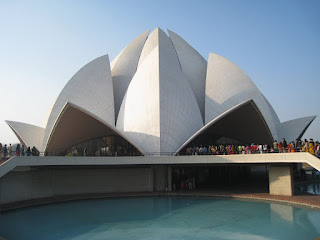Update: Now with actual stories!
Fatehpur Sikri: http://en.wikipedia.org/wiki/Fatehpur_Sikri
Fatehpur Sikri proved to be quite a stunning fort. It was built in the middle of the 1500’s by the Mughals, who seemed to be the most adept Indian rulers at building anything (They are also responsible for the Taj Mahal). Built as a palace and town, it was eventually abandoned as a palace when the capital was moved back to
After the formal tour of the palace town, we met with with Mr. Faridi, who gave us a personal tour of the rest of the complext. We were able to go into the tomb of the saint and tie hope strings to the wall. Then we were fortunate enough to climb up the tower, to a point where other people are not normally allowed to go. The view was breathtaking.
We were invited to have lunch with Mr. Faridi, which turned out to be the best Indian meal I have ever had, by far. Along with a wide variety of chicken, mutton, cheese, rice, and roti, he served Zerda. Zerda is an orange rice, with caramelized grapes, some unnamed red sweet rice, with almonds and some other fruit. It was originally brought out after everyone was already full, but yet each person had at least three servings. We were all going to burst.



Taj Mahal: http://en.wikipedia.org/wiki/Taj_mahal
Although we were supposed to leave Fatehpur Sikri around 1:00, it was now around 3:45, and we needed to get to the Taj Mahal before it closed. Despite his exceedingly fast (read: completely insane) driving style, our new driver, who was named Zafer, was not able to get us to
Finding a hotel proved to be extremely easy, despite it being high tourist season. We made plans to wake up and see the Taj as it opened.
When we got to the gate the next morning, we realized that the fog in place would prohibit us from seeing the true sunrise reflecting on the Taj, but that did not stop our enjoyment of the complex. There is an outer garden, with a gate inscribed with a few verses from the Koran leading into the main area. When I turned the corner and was able to see the actually Taj Mahal, I was blown away. It is one of those awe-inspiring structures that looks so amazing when you see it in pictures, but in the back of your mind you know it is so much better in person. Well, it is. Instead of creating a disappointing effect, the fog made the Taj look mystical.
We spent about four hours walking around the area, investigating all of the interesting vegetation, the mosque, the actual Taj, and the columns. I found it very interesting that the columns were built to lean slightly outward, so that in the event of a catastrophe, they would fall outward. We all agreed that the most amazing part is the simplicity. The architecture itself is very simple and stunningly elegant. The Taj Mahal is definitely on a short list of the most impressive things I have seen in my life.
That evening, we took a train back to


Humayun's Tomb: http://en.wikipedia.org/wiki/Humayun%27s_tomb
While Mike was working to resolve some computer problems, Sam and I went to Humayun’s tomb. Leaving most of the history out, this was another very impressive structure. We noticed that whenever a site gets UNESCO world heritage status,
Anyway, Humayun’s tomb is very impressive. It predates the Taj Mahal and was actually used as the main source of inspiration for it. Upon entering, there is another tomb on the right side, but walking straight leads to the tomb. I liked the white marble used for the Taj Mahal better than the red sandstone used here, but nonetheless it had a simple elegance as well. I actually liked the surrounding garden, with plenty of beautiful trees better than the surrounding area in the Taj Mahal complex.


Qutub Minar: http://en.wikipedia.org/wiki/Qutub_minar
The next day, we went to Qutub Minar, which is quite an elegant structure (again, built by the Muslims) in
It was here that I had my first up close and personal encounter with the ever-present caste system. Despite having purchased tickets, two teenage boys were slapped across the face at full force by a guard, simply because they were not in the proper caste to enter. Nearly everyone with any money in

Bahai Lotus Temple: http://en.wikipedia.org/wiki/Lotus_Temple
After leaving Qutub Minar, we headed to the
Well, that concludes our time in




No comments:
Post a Comment